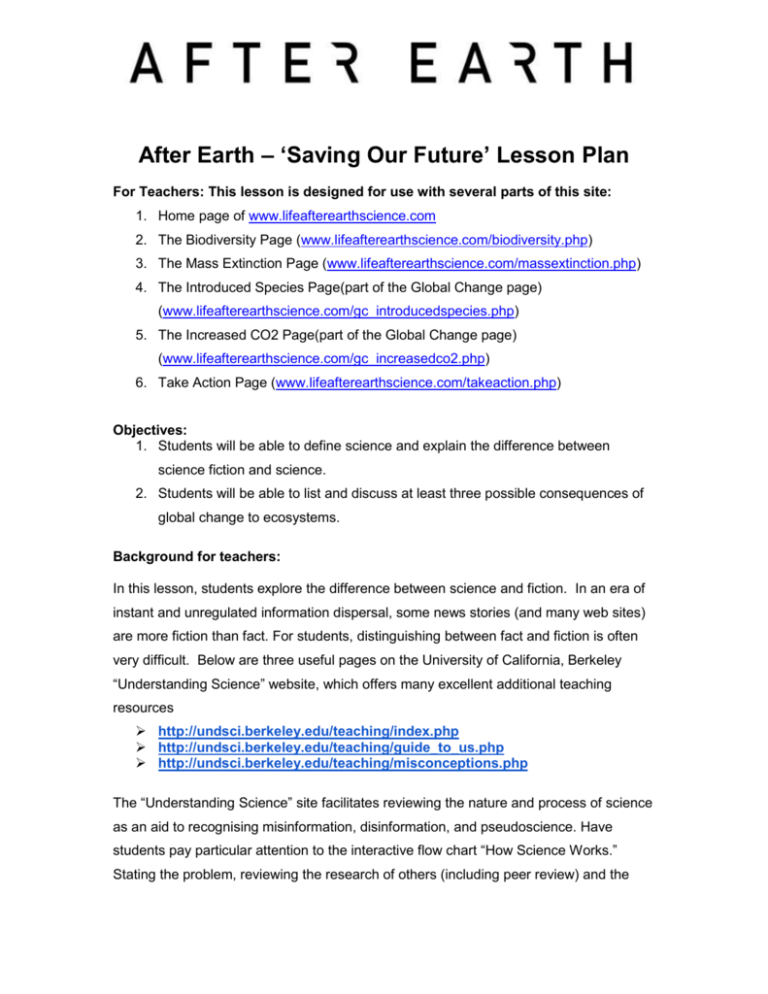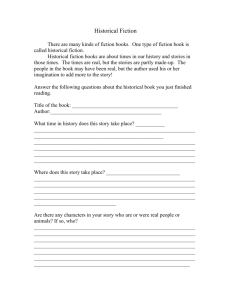Saving Our Future
advertisement

After Earth – ‘Saving Our Future’ Lesson Plan For Teachers: This lesson is designed for use with several parts of this site: 1. Home page of www.lifeafterearthscience.com 2. The Biodiversity Page (www.lifeafterearthscience.com/biodiversity.php) 3. The Mass Extinction Page (www.lifeafterearthscience.com/massextinction.php) 4. The Introduced Species Page(part of the Global Change page) (www.lifeafterearthscience.com/gc_introducedspecies.php) 5. The Increased CO2 Page(part of the Global Change page) (www.lifeafterearthscience.com/gc_increasedco2.php) 6. Take Action Page (www.lifeafterearthscience.com/takeaction.php) Objectives: 1. Students will be able to define science and explain the difference between science fiction and science. 2. Students will be able to list and discuss at least three possible consequences of global change to ecosystems. Background for teachers: In this lesson, students explore the difference between science and fiction. In an era of instant and unregulated information dispersal, some news stories (and many web sites) are more fiction than fact. For students, distinguishing between fact and fiction is often very difficult. Below are three useful pages on the University of California, Berkeley “Understanding Science” website, which offers many excellent additional teaching resources http://undsci.berkeley.edu/teaching/index.php http://undsci.berkeley.edu/teaching/guide_to_us.php http://undsci.berkeley.edu/teaching/misconceptions.php The “Understanding Science” site facilitates reviewing the nature and process of science as an aid to recognising misinformation, disinformation, and pseudoscience. Have students pay particular attention to the interactive flow chart “How Science Works.” Stating the problem, reviewing the research of others (including peer review) and the validity of computer modeling as experimental methodology are all part of the scientific method. Help students understand how each of these elements fits into the model. Overview: Directions are contained in the body of the student activity sheets. First students are asked to look up some terms. You may provide these or have students look them up on the web and agree on them. Second, students explore current discoveries of new species. Next students (in groups or individually) will research the ancestors of the three species that present challenges for the characters in After Earth. This could be a homework assignment or a research based class assignment. Alternatively, three students could do this research as extra credit and present their research. This would enable you to skip the research component for the class. When groups have finished researching their creatures, have them either present to the entire class or have them form “super groups” that have all three animals represented, to share information. (Skip this if the whole class has seen presentations on real animals.) Last, students will consider some science and predictions relating to different categories of global change, (Mass Extinction, Biodiversity, Invasive Species, Increasing CO2), and present those to each other. They will also access the Take Action webpage, and explore the actions that we as citizens might take. If your class is larger than 4 groups of 3-5 students, you can double-assign categories. Possible Formative Assessments: 1. Final presentations-- in class 2. In the film After Earth, people ignored the warning signs of global change. Write a letter to your local Member of Parliament explaining your concerns about current global changes. 3. Last question is written as an essay “What role do you think Science Fiction has in helping people to make change in society?” OR what role do you think the film After Earth can have in helping with global climate change? After Earth: Saving Our Future Lesson Plan Objectives: 1. Students will be able to define science and explain the difference between science fiction and science. 2. Students will be able to list and discuss at least three possible consequences of global change to ecosystems. "Seeing this gradation and diversity of structure in one small, intimately related group of birds, one might really fancy that from an original paucity of birds in this archipelago, one species had been taken and modified for different ends".—Charles Darwin Vocabulary: Look up each of these terms and write down the definition: Adaptation Population Habitat Biodiversity Mass Extinction Natural Selection Imagine Charles Darwin, as a young man sailing aboard HMS Beagle in the 1830s, encountering spectacular and amazing creatures entirely new to him. Did you know that we are STILL encountering new species on earth? Try this: do a web search using the following key words: “new species discovered in 2013”. (Or use another year from this decade.) Choose three of those articles to read and write a three-sentence summary for each below: Website:____________________________________________ o Title of article____________________________ o Creature is alive now or fossil?_________ o Summary: Website:____________________________________________ o Title of article____________________________ o Creature is alive now or fossil?_________ o Summary: Website:____________________________________________ o Title of article____________________________ o Creature is alive now or fossil?_________ o Summary: **The blend of Science and Fiction** In the film After Earth, several creatures seem recognisable, but are quite different from those we know today. This is one of the delights of science fiction—thinking about what life might be like in the future, or if conditions were just a bit different—and making up a story. Let’s see how some of the story and science go together. Write down three similarities and three differences between being Charles Darwin exploring the world in 1832 AD and Kitai in the film After Earth exploring the Earth in 3072 AD. Comparison of a real explorer and a fictional explorer: Charles and Kitai Similarities Differences Where would YOU like to explore to find a new creature? How likely do you think you would be to find one? As we humans struggle to make order out of chaos, we make observations about organisms we see. We look at individual characteristics of organisms, notice their use, and call these “adaptations.” Considering the adaptations of plants and animals may be a useful way of organising life. To look more closely at how this might work, we’ll start with you. Humans have many adaptations that make us good at surviving. For example, we have what is called an “opposable” thumb, which means that we can make a fist, or pick a piece of fruit from a tree. We can also HOLD that same piece of fruit easily while we eat it. This adaptation, therefore, is one of the things that enables us to be successful in harvesting fruit (and other foods) and feeding ourselves. Let’s look more closely at three creatures that appear in the film but have realworld counterparts on earth right now – the Leech, the California Condor and the Flying Snake. You will work with a group of 2 or 3 classmates, and your teacher will direct group assignments. (Alternatively, your teacher may have some students present this material to the entire class.) You and your group should choose one of the creatures to research using the Internet. 1. Leech (make it a local one) Research and present: Structure and Function Drawing--labeled, all parts! How it feeds--including how it keeps blood from its host flowing What eats it? Definition of “parasite”--how does this word apply to this animal? How its hosts get rid of it Describe the habitat in which they live Relate their body adaptations and their behaviours to survival in the place where they live. (Think about the definition you have learned for “adaptation” and what that really means.) 2. California Condor Research and present: Structure and Function Drawing--labeled, all parts!! How it feeds--what does it eat? What eats it? Definition of “carrion”--how does this word apply to this animal? Describe the habitat in which they live Relate their body adaptations and their behaviours to survival in the place where they live. (Think about the definition you have learned for “adaptation” and what that really means.) 3. Flying Snake--from Asia Research and present: Structure and Function Drawing--labeled, all parts!! How it feeds--what does it eat? What eats it? Definitions of “predator”; “top carnivore”--do these words apply to this animal? Describe the habitat in which they live Relate their body adaptations and their behaviours to survival in the place where they live. (Think about the definition you have learned for “adaptation” and what that really means.) Present the material about your animal to the other two groups in class. Take notes on the information presented by the other groups. What is the difference between Science and Fiction? Take a look at the following websites: http://undsci.berkeley.edu/article/scienceflowchart http://undsci.berkeley.edu/article/intro_01 Discuss at your table which parts of this lab so far have been science, and which parts fiction? In the film, the three animals (about which you just presented scientific facts) have special roles because they have evolved new traits over the time humans have been gone from planet Earth. (Think: fact or fiction?) In the fictional history of After Earth, the ancestors of Kitai (Jaden Smith) and Cypher (Will Smith) ignored the warning signs of global change. Now consider some real-world scientific evidence. Divide the class into groups. Each group will receive a webpage to explore and report back to the class. Mass Extinction, Biodiversity, Introduced Species, Increased CO2. (If your class is larger than four groups, categories can be double-assigned) Enter the link to the webpage that you and your group have been assigned. Take notes below. Now look back at the Ecosystem Services Graphic located on the Biodiversity Page. Discuss as a group: which ecological services (the benefits arising from the ecological functions of healthy ecosystem) are most directly related to the information you just read and wrote down above? List the Ecological Services affected by your issue below. For each, tell HOW it is being affected. Prepare to present the facts from your research to the rest of the class. You and your group will design an interview to present your information in a skit. You can assume the roles of scientists, reporters, natural resource managers and government officials as needed. With your group, consider the outline below: What is the name of this phenomenon (It might be the title of the website you visited)? Who is causing this and who (or what) is affected? Where is it happening? When is it happening? Why is it happening? How might it interfere with ecological services? Now visit the After Earth “Take Action” web page and answer these questions: Read the first two paragraphs. Discuss this sentence, which appears in the second paragraph, with your group: “Safeguarding global ecosystem services must go hand in hand with ending global poverty or neither effort can succeed.” How does global poverty factor into global climate change? The first sentence on the “Take Action” page states “The most important action you can take in the face of global change is simple: do something!” What actions can we (the public/regular people) take?? (Think both small and big actions. Think daily, monthly and yearly. Think this year and next year and the year after that.) Include these recommendations in your report/presentation to the class. After the class has seen all the presentations of the different groups: Discuss or write the answer to this question: What role do you think science fiction can have in helping people make changes in society?





